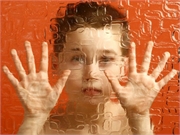WEDNESDAY, Aug. 19, 2020 (HealthDay News) — With the likelihood that many kids will be taught remotely this fall, all children are bound to face obstacles to their learning and development. But kids with disabilities often require more support, some of which cannot be delivered remotely.
“The burden of stress on the families of children with disabilities is significant, and even more so during the pandemic when the supports typically available are not accessible, and interaction with extended family and friends is not possible,” said Dr. Olaf Kraus de Camargo, an associate professor of pediatrics at McMaster University in Hamilton, Ontario, Canada.
“We know the pandemic has taken a particular toll on these families, many of whom have found their situations daunting,” he added.
As a developmental pediatrician, Kraus de Camargo treats children with a variety of disabilities — chronic disorders that affect movement such as cerebral palsy; cognitive disabilities such as autism; learning disabilities, and speech deficiencies.
“And often these conditions are also superimposed with mental health conditions like anxiety and depression,” Kraus de Camargo added.
Depending on their particular condition, children with special needs may need a team of doctors — potentially including psychologists, speech and language coaches, occupational therapists and social workers.
But since the beginning of the COVID-19 pandemic, receiving the same amount of care may not be possible in person.
For some children who don’t suffer from severe medical conditions or disabilities, telemedicine may be sufficient.
Dr. Nerissa Bauer is a behavioral pediatrician at Axon Health Associates in Indianapolis. She mostly treats children with attention-deficit hyperactivity disorder (ADHD), and some with autism.
She said that seeing her patients virtually has had some benefits. “I think that a majority of my families do like the accessibility of telehealth and the availability of doing it from their home without having to go out,” Bauer said. “It’s been so nice to see families in their natural environment, where kids feel much more comfortable.”
But not all care can be delivered remotely, and there are many circumstances in which virtual care is inadequate.
In normal times, a child with autism, for example, may participate in peer-to-peer workshops to help them develop their social skills. But conducting this kind of workshop virtually may not be feasible or effective.
And without school, autistic children with social deficiencies are missing out on building essential social skills. “Some schools have social communication classrooms,” Kraus de Camargo said. “They have a social-skills training for these kids that have been very successful in making them more comfortable in social interactions.”
Without these kinds of services, children’s development can regress. “They can lose the ground they gained during treatment,” Kraus de Camargo explained.
Kraus de Camargo gave one example of an 8-year-old autistic boy who refuses to eat normally — a condition called pediatric feeding disorder. “Before the pandemic, he was making progress by participating in feeding workshops, which helped him to tolerate different foods and textures,” Kraus de Camargo said. “Since March, he has stopped trying new foods and now is back to only McDonald’s french fries and Fruitopia.”
The boy’s mother was afraid to take her son to the doctor for fear of him catching COVID-19. “This child is regressing in his skills and probably already has nutritional deficiencies,” Kraus de Camargo added.
But other experts believe that this moment is opening up possibilities for children with special needs who weren’t receiving proper care before the pandemic.
“There are so many resources now that are web-based,” said Dr. Brad Berman, a developmental pediatrician at Benioff Children’s Hospitals at the University of California, San Francisco.
If they are able to, Berman advises the parents of his patients to experiment with alternative learning styles that can be taught outside of the classroom.
One of Berman’s patients — an eighth-grader with high-functioning autism — had been struggling in school, and the situation worsened when remote learning took hold in March.
“The mom wanted to know what to do,” Berman said. “So we talked about what they can do naturalistically. You want to teach them higher-level math? Let’s collect a bunch of pill bugs. Measurement and geometry? Start teaching him how to bake. For students who learn differently or uniquely, that could be all the difference.”
Of course, most parents cannot take the time to teach their children on top of their own jobs.
That’s why the burden on parents of children with special needs is exceptionally high right now.
“Working from home, teaching from home, providing some therapy supports or other supports for the child — that has a huge impact on the family,” said Kraus de Camargo.
More information
There’s more about caring for children with special needs at healthychildren.org.
Copyright © 2025 HealthDay. All rights reserved.

